
30 minute read
After 5: Copenhagen
Unplug and Play
Get cozy in Copenhagen when the work day ends. BY ALLIE MOORE
Advertisement
WITH ONE OF THE WORLD’S (if not the world’s) strongest commitments to sustainability combined with an extremely balanced work-life culture, Copenhagen draws working professionals to its winding streets, nearly 60 percent of which are occupied by cyclists. Once businesses and shops close for the day, the Danish capital embraces hygge, a Danish term that refers to locals’ appreciation for coziness in every sense of the word.
Copenhagen residents know how to disconnect after a work day, explaining why the city ranks third in the world for social inclusion and prosperity. Locals and visitors are encouraged to come together to reap what the city sows, an example of which lies in this summer’s new public gardens, where fresh fruit will be ripe for the picking. Along with these accolades, Copenhagen plans to be completely carbon-neutral by 2025.
Before the sun sets (which can be very early during the winter months), book a spot on Copenhagen’s GoBoats for a unique perspective of the city from the surrounding harbors. The eco-friendly boat tour company also offers GoBoat After Work, which moves the meeting room to one (or up to eight) of GoBoat’s eight-person boats, with the option to add food and beverages.
If you’re not sure where to begin a culinary journey through Copenhagen, leave it in the hands of Foodtours.eu, whose Evening Gourmet Stroll starts with tastings at the market halls of Torvehallerne followed by dinner at a nearby restaurant and then beer and dessert in the melting-pot neighborhood of Nørrebro.
Last November famed Danish chef Kamilla Seidler opened her first solo restaurant, Restaurant Lola, on the outskirts of Copenhagen’s famous Freetown Christiania neighborhood. Beyond the eatery itself, the Lola Impact restaurant initiative helps underprivileged and marginalized groups glean cooking techniques and culinary basics as well as learn how to build relationships and work as a team. When Seidler isn’t managing Lola, she’s fighting for gender equality rights in the restaurant industry with Food Organisation of Denmark.
End any night in Copenhagen with an illuminating stop at Tivoli Gardens, Europe’s oldest amusement park, open until 11 p.m. from mid-April to mid-September, followed by a nightcap at Oscar Bar | Café, an LGBTQ+-friendly bar and restaurant near City Hall.

ALL AGLOW: Copenhagen waterfront (top), and Tivoli Gardens at night (bottom) PHOTOS: © SERGIYN - DREAMSTIME.COM, © SEAN PAVONE - DREAMSTIME.COM
FOR ALL THE MOMENTS WE STAND UP

Since 2008, Major League Baseball ® has supported Stand Up To Cancer in its mission to fund groundbreaking research and get treatments to patients faster than ever before. Join us as we stand united to show our support for loved ones affected by cancer.

Visit StandUpToCancer.org/MLB

JORDANA BREWSTER Stand Up To Cancer Ambassador



City by the Sea
Halifax strives to showcase and protect its natural wealth. BY DALE LEATHERMAN

Pier 21, where immigrants from all over the world entered Canada between 1928 and 1971, is a repository of personal stories and resources for visi tors seeking their family roots.
LOCAL LANDMARKS: The Bicycle Thief (left), and the Halifax Town Clock on Citadel Hill (right)
PHOTOS: © DARRYL BROOKS - DREAMSTIME .COM, © MAURIZIO DE MATTEI - DREAMSTIME .COM
“FROM THE SEA, WEALTH.” The motto says a lot about Halifax, the capital of Nova Scotia, a Canadian province almost surrounded by the Atlantic. Though visitors and locals gravitate to the waterfront, a good introduction to the city is the hilltop Citadel, a 244-year-old fortress with a panoramic view of the city and its strategic harbor.
A short walk from the Citadel, the Maritime Museum of the Atlantic exhibits the city’s history as a pirate hangout, commercial port and base for warships. Artifacts from the 1912 sinking of the Titanic offer a grim reminder of the city’s role in recovering the dead, 121 of whom are buried locally in Fairview Lawn Cemetery. Another exhibit recounts the Halifax Explosion of 1917, when a ship collision set off the world’s largest accidental manmade explosion, killing 2,000 residents and injuring 9,000.
Near the museum lies the waterfront, where the Royal Canadian Navy’s Atlantic Fleet bases its operations, but most harbor traffic comprises yachts, sailboats, tour boats and cruise ships. A boardwalk connects almost three miles of shops, galleries, bars, restaurants, NEW BRUNSWICK Bay of Fundy


museums and tour offices. Benches and hammocks offer vantage points for enjoying the ever-changing view. Get even closer to the action with themed cruises (wine, craft beer, history, nature). Among the harborside eateries enjoy local favor ites such as The Bicycle Thief (Italian), Salty’s (seafood) and the Stubborn Goat Gastropub (tapas, comfort food).
At the waterfront’s southern end explore Halifax Seaport Farmers Market, where more than 250 vendors ply their wares in a restored, LEED Gold-certified warehouse with a rooftop patio and garden. Nearby, the Canadian Museum of Immigration at Pier 21 commemo rates the site where a million people entered the country. The Westin Nova Scotia, the grande dame of Halifax hotels, overlooks the Seaport. Built in 1930 and a frequent host to royals and celebrities, it has gone green with aggressive energy saving, recycling and composting initiatives. The hotel keeps in step with Halifax in realizing its wealth does come from the sea. Accordingly, Haligonians embrace Canada’s plans to ban single-use plastics by 2021 and to retrieve “ghost fishing gear” — lost tackle, lines and traps that harm marine life. NOVA SCOTIA PRINCE EDWARD ISLAND
Atlantic Ocean Halifax
CHENGDU BEIJING TAIPEI TOKYO (NARITA AND HANEDA) VANCOUVER CALGARY WINNIPEG TORONTO (PEARSON) OTTAWA TORONTO (CITY) MONTREAL QUEBEC CITY HALIFAX REYKJAVIK MADRID DUBLIN EDINBURGH LONDON (HEATHROW AND GATWICK) PARIS BRUSSELS FRANKFURT ROME MUNICH VENICE ATHENS PRAGUE (STARTS 5/2020)
VIENNA BUDAPEST WARSAW AMMAN ABU DHABI DOHA ISTANBUL DELHI
HONG KONG SHANGHAI SEOUL BRISBANE (STARTS 4/2020)
AUCKLAND LOS CABOS PUERTO VALLARTA DURANGO GUADALAJARA ZACATECAS MORELIA LEÓN MONTERREY IXTAPA AGUASCALIENTES LIBERIA MEXICO CITY SAN JOSE BELIZE CITY COZUMEL CANCUN QUERETARO HUATULCO GUATEMALA CITY GRAND CAYMAN PANAMA CITY NASSAU MONTEGO BAY PROVIDENCIALES ARUBA PUNTA CANA

SAO PAULO ST. MAARTEN ST. LUCIA LISBON BARCELONA AMSTERDAM ZÜRICH TEL AVIV (STARTS 3/2020)
COPENHAGEN KRAKOW STOCKHOLM HELSINKI ADDIS ABABA DUBAI
Chicago’s airports offer more than 275 nonstop destinations worldwide.
CONNECTING THE WORLD TO CHICAGO AND CHICAGO TO THE WORLD
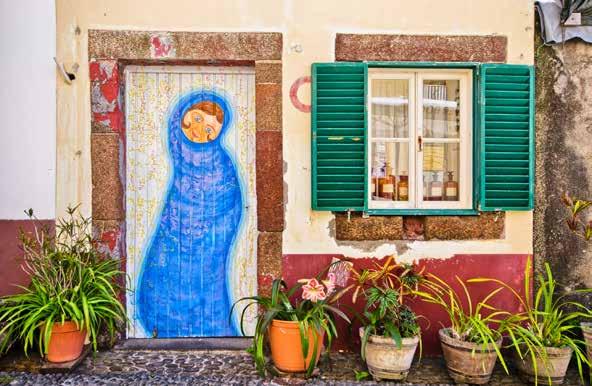
Picture Perfect

Explore Madeira in all its mesmerizing natural beauty. BY IRENE RAWLINGS
ICONIC COLORS: (Left to right) Mercado dos Lavradores in Funchal, painted doors, and Monte Palace Tropical Garden in Funchal
PHOTOS: © STEVE ALLEN - DREAMSTIME.COM, © CCAT82 - DREAMSTIME .COM, © GUNOLD - DREAMSTIME.COM, © GUNOLD - DREAMSTIME .COM, © CCAT82 - DREAMSTIME.COM
DRAMATIC MOUNTAINS. INTOXICATING VISTAS. Spring-like weather. And 5-star hotels. All this originally attracted an older, moneyed crowd to the Portuguese island of Madeira — located in the Atlantic, 700 miles from the Portuguese mainland. George Bernard Shaw learned to tango on the lawn of the iconic Reid’s Palace Hotel (now a Belmond). Sir Winston Churchill came here to paint the island’s staggeringly beautiful seascapes.
But recently the picture on this verdant 35- by 13-mile volcanic island has begun to change.
The silver-haired aristocrats are still here, but so
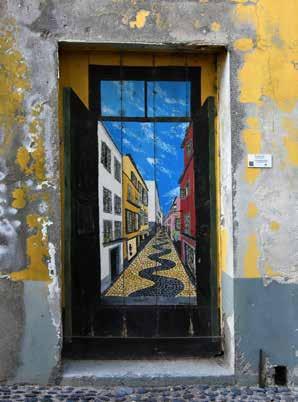
are entrepreneurs attracted by the EU’s favorable business climate for startups, young families escaping the cold northern winters, and hardy adventure seekers. These include surfers looking for world-class waves, cave divers exploring the underwater caverns, distance runners getting fit on ocean trails (think Chariots of Fire) and cyclists braving gravity-defying inclines and the ever-changing weather. Local outfit ters like Terras de Adventura and LokoLoko can provide gear and guides.
Start your visit in Funchal, Madeira’s capital city. The name comes from the fragrance of wild fennel (or funchal) that perfumed the air 600 years ago, when the Portuguese discovered the island. Today visitors flock to the old town with its narrow, cobbled streets. Stop at the interactive Madeira Story Centre for a glimpse of Madeira’s colorful past, including numer ous attacks by pirates. Have lunch on the rooftop restaurant. Children of all ages will enjoy Museo do Brinquedo; the toy museum features more than
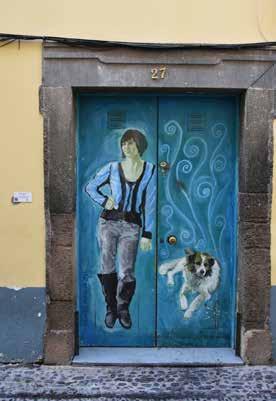
INFO TO GO Most international airlines fly to Lisbon (LIS). TAP Air Portugal and others offer a domestic flight from Lisbon to Madeira’s Cristiano Ronaldo Madeira International Airport (FNC), with a flight time of about one hour and 45 minutes. The airport lies 14 miles from the island’s capital, Funchal. Taxis cost about $35. Another option: Madeira Airport Transfers for pre-booked service anywhere on the island.
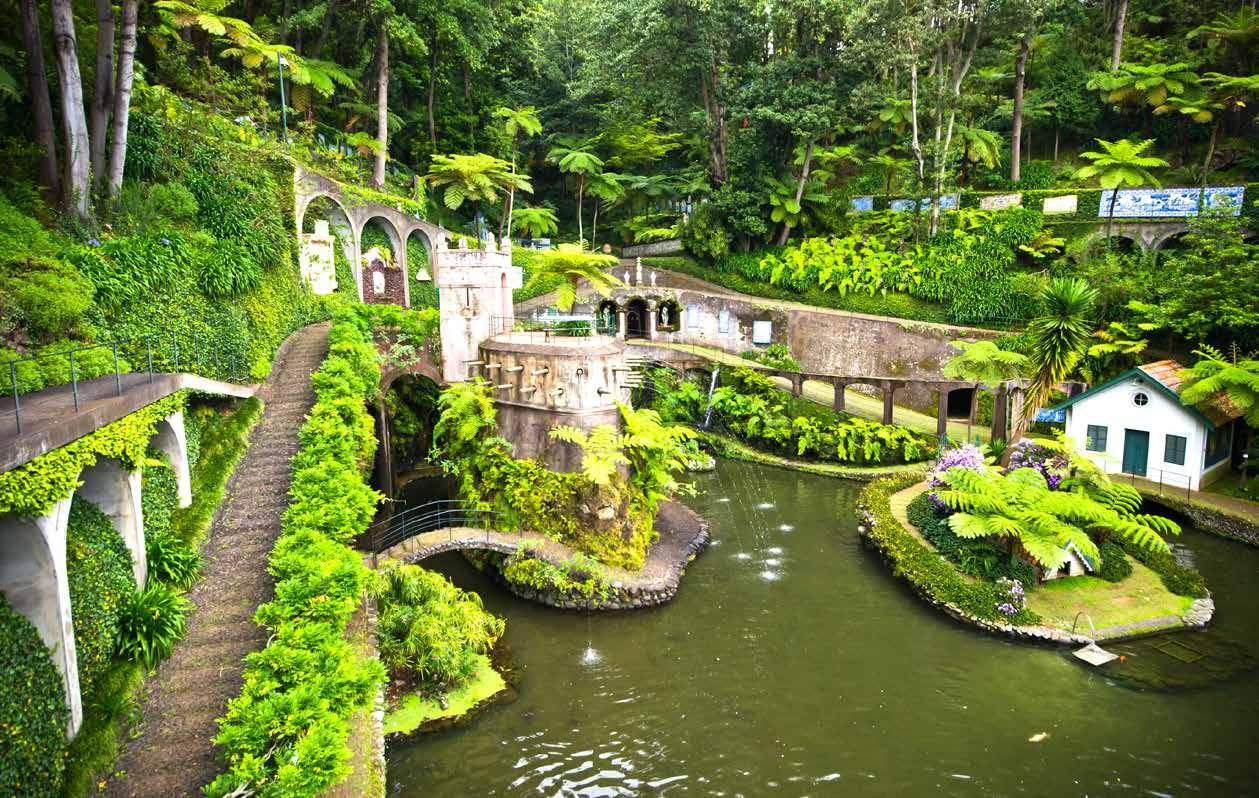
20,000 cars, dolls and even vintage Star Wars action figures. Stroll down Rua de Santa Maria to admire the Art of Open Doors Project, with imaginative scenes depicted on the front doors of each little house and shop.
On Saturday mornings take the family to Mercado dos Lavradores and admire the building’s blue- and white-tiled façade. Then wander through the farmers market, tasting tropical fruits. Start with the honey-scented, no-bigger-than-your-finger bananas. Don’t miss the custard apple and the philodendron fruit that looks like a pineapple and tastes like a banana. Chat with the colorfully attired flower vendors selling fragrant lilies, roses, orchids and birds of paradise. The downstairs fish market is not for the faint-hearted. Along the perimeter of the market, small bars sell drinks and snacks.
Even if you are not religious, consider attending a service at Funchal Cathedral (con secrated in 1514) to admire the painted cherubs, gilded statues of saints and apostles and, especially, the traditional Portuguese knotwork (alfarge) ceiling. From the old town take a spectacular cable car ride up to Monte (kids under 6 ride free). The rich Madeirenses lived here in the heyday of the sugar cane industry, high above the hustle and noise of the commercial port. Take in the fresh air up here and the endless panoramic views. Many of the 17th- and 18th-century homes and gardens still exist. Stop at the Monte Palace Tropical Garden to enjoy lakes, waterfalls and exotic species of native trees and flowers.
If you have thrill-seeking teens in tow, they’ll love the trip back down the mountain — a
LODGING
BELMOND REID’S PALACE HOTEL Perched on a rocky promontory overlooking the Atlantic, this elegant hotel has hosted princes and sheikhs since 1891. Enjoy Champagne buffet Sundays, dinner dance Mondays and afternoon tea on the terrace, daily. Buffet breakfast included. Estrada Monumental 139, Funchal $$$$
CASA VELHA DO PALHEIRO This 37-room chintz- and antiques-filled hotel feels like
an English country house, offering a heated pool set in luxuriant gardens, sauna and steam rooms, tennis, croquet and billiards. Private yacht for deep-sea fishing available. Rua da Estalagem 23, Funchal $$$$
SAVOY PALACE Shaped like an undulating wave, the recently reopened, retro-chic hotel features 352 rooms, five pools, six restaurants and bars, a cigar club and a 32,000-squarefoot spa. All rooms have sea views. Ave. do Infante 25, Funchal $$$
LEISURE TIME: Levada trail (top), and Porto Moniz natural swimming pools (bottom)
PHOTOS: © SIMONDANNHAUER - DREAMSTIME.COM, © PETR ŠVEC - DREAMSTIME.COM
DINING
IL GALLO D’ORO Boasting two Michelin stars, the restaurant changes its menu frequently but always offers freshly caught fish. Its 400-bottle cellar includes vintages dating to the 1860s. Reserve a table on the terrace for great views. Estrada Monumental 147, Funchal $$$$$
RESTAURANTE DO FORTE Atop the battlements of 17th-century São Tiago fort sample a local favorite: black scabbard fish with fried bananas. The menu also includes creamy seafood risotto and vegetarian options. Classic car pick-up at your hotel. Rua do Portão de São Tiago, Forte de São Tiago, Funchal $$$$
RESTAURANTE TOKOS Enjoy unhurried dining in a 12-table restaurant run by a husband and wife in a 100-year-old house. Just-caught fish and local seafood star, grilled to order and accompanied by fresh vegetables. Reservation essential. Estrada Monumental 169, Funchal $$$$
hair-raising ride down a curvy road in a wicker sleigh guided by two straw-hatted and white-trousered carreiros, whose thick rubber-soled shoes provide the sleigh’s only brakes. A popular form of downhill transportation since the 1850s, the sleighs can reach speeds up to 30 mph. To explore the rest of the island rent a car; or if you’re not comfortable navigating mountain roads with seemingly impossible hairpin turns, hire a car and driver for the day.
Madeira wows visitors with pretty villages like São Vicente, boasting white-walled houses with deep-green shutters and red roofs. Visit the 17th-century church before heading to Grutas de São Vicente, caves created by underground channels of lava from eruptions that occurred more than 400,000 years ago.
Visit Porto Moniz to splash in lava pools naturally filled by the ocean’s high tides (go early before the tour buses from the cruise ships arrive). Take a dolphin-, whale- and turtle-watching cruise by speedboat or leisurely catamaran. Drive out to the postcard-pretty Ponta do Pargo lighthouse on the most westerly point of the island.
Put on your high-tops for a levada walk — essentially narrow walkways along ancient irrigation channels cut into the moun tains nearly 600 years ago. The more than 1,200 miles of trails offer a range of hikes from easy strolls to good workouts. Go with a guided group like Madeira Levadas or Go Trail Madeira, or download a map and head off on your own.
Any trip to Madeira must include sampling the fortified Madeira wine. Some drink it as an aperitif; others like it with the cheese course, and still others drink it with tonic water over ice. Book a Premium Tour at Blandy’s Wine Lodge for a tasting of both young and rare vintages. Stay for a wine-paired tapas lunch at the small 1811 Bistro & Wine Bar.
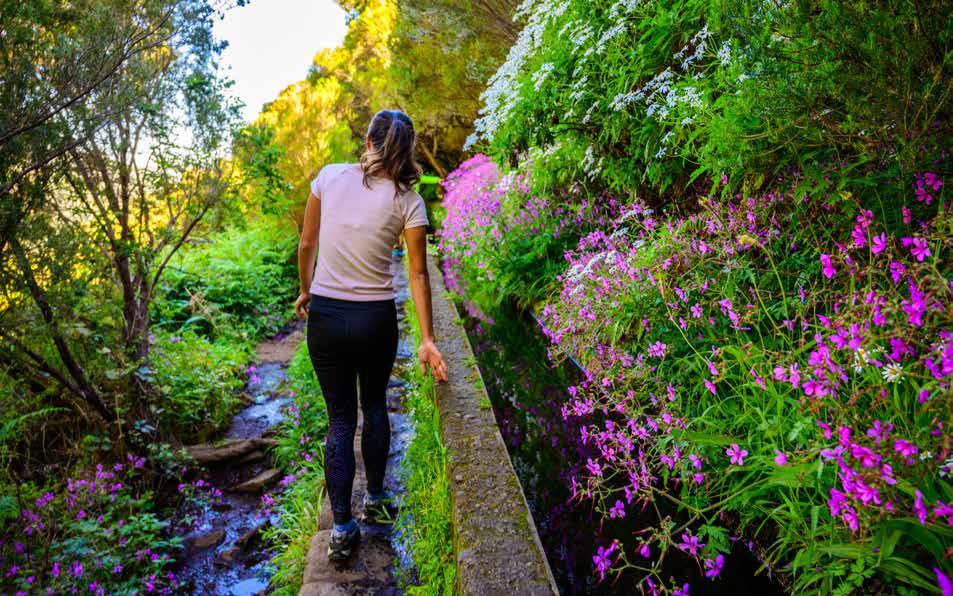
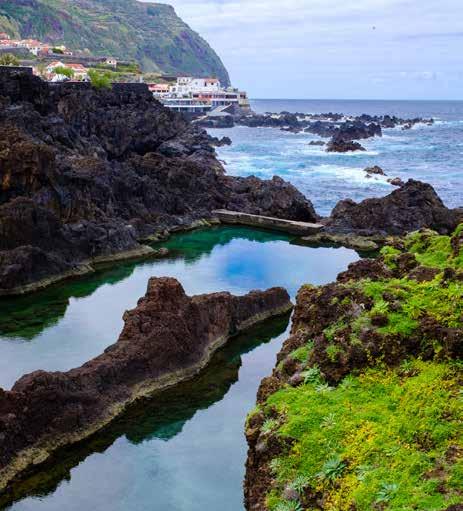
Although Madeira boasts 99 miles of coastline with gor geous azure waters, it has few natural sand beaches. For serious beaching, even locals fly over to neighboring Porto Santo, a tiny speck of an island with miles of golden-sand beach. The flight takes only 15 minutes. Porto Santo, a popular scuba destination, offers dives to view ancient cannons and explore a wrecked cargo ship but remains a still-under-the-radar golf destination. Famed Spanish golfer Severiano Ballesteros designed the fun, challenging and always windy 18-hole course.

All the comfort you’d expect from business class, at a lower-than- expected price. When you fly TAP you’ll also get the option to stopover in Portugal on your way to over 70 destinations in Europe and Africa.
Taste of the Town
Sample the local food and culture on a culinary tour of Montevideo. BY KRISTY ALPERT
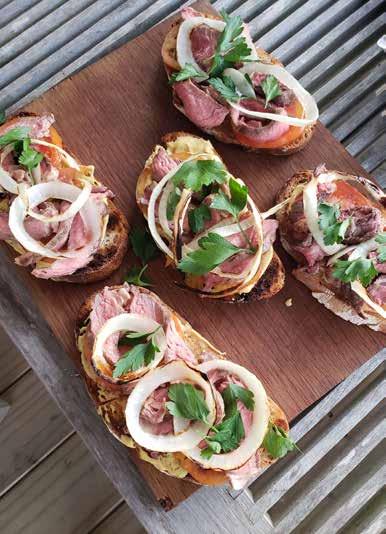
WEDGED BETWEEN ARGENTINA AND BRAZIL along Rio de la Plata’s Atlantic waters, Montevideo may be small, but it remains one of the most sophisticated and progressive capital cities in South America. Locals take pride in their city’s cleanliness, quality of life and vibrant culture. Many spend their mornings and afternoons in-line skating, jogging or lifting weights along the city’s 17-mile-long seafront esplanade before gathering for cortados and dulce de leche pastries during a 5 p.m. merienda (Uruguayan afternoon tea/snack). “Uruguay is an incredible country with a wide range of options for honeymooners, family trips, friends’ trips but also solo travelers,” explains Diana Wrangham, Uruguay travel expert, Black Tomato. “The countryside that surrounds Montevideo is a destination in itself, boasting rolling plains and [a] wide range of wineries, while Montevideo houses many of the most beautiful and well-kept buildings of Latin America, including Palacio Salvo and Cerrito de la Victoria.”
Uruguay can also boast about its environmental policies. In less than 10 years, the country slashed its carbon footprint and lowered electricity costs without government subsidies. Renew ables now provide 94.5 percent of the country’s electricity. Rated as one of the most literate countries in South America, Uruguay’s low crime rate and corruption-free govern
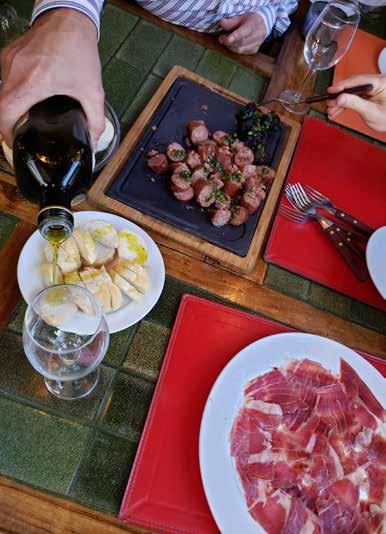
ment cultivate a capital city in which creative energy thrives. Montevideo houses countless art galleries such as Museo Torres García, Museo Gurvich and Espacio de Arte Contemporaneo, but it’s the culinary arts that now flavor the city with creativity. Nearly every culinary tour includes a visit to one of Francis Mallmann-protégé Chef Lucia Soria’s market-driven restaurants, Jacinto Café and Restaurant and Pizzeria Rosa. However, the offerings from Bueme’s Travel take visitors behind the scenes to explore the colorful markets and even meet the makers themselves with hands-on charcuterie workshops, wine blending sessions and cooking classes with Montevideo residents.
Montevideans celebrate their rich gaucho heritage daily, cooking hearty cuts of grass-fed steaks over urban asado grills and pairing them with heavy pours of local Tannat wine. Visitors can get the true gaucho experience with Lares Tours. The local company pioneered active and experiential tourism in Uruguay, offering tours on horseback, bicycle and paddle boards, along with a wide range of specialty tours focused on everything from family-friendly activities to birding. Consider its self-driving tour of Montevideo and the surrounding areas for a great way to take in the city’s natural beauty at your own pace.

LOCAL FLAVOR: (Left to right) An open-faced sandwich with grass-fed beef and charred onions, a light drizzle of Uruguayan olive oil to complement housemade charcuterie at the Mercado del Puerto, and freshly made empanadas at Chef Lucia Soria’s Jacinto Café and Restaurant
PHOTOS: © KRISTY ALPERT
Montevideo is famous for its roasted and barbecued meat called parrilla, but adventurous eaters will love morcilla, a blood sausage prepared either dulce (sweet) or savory.
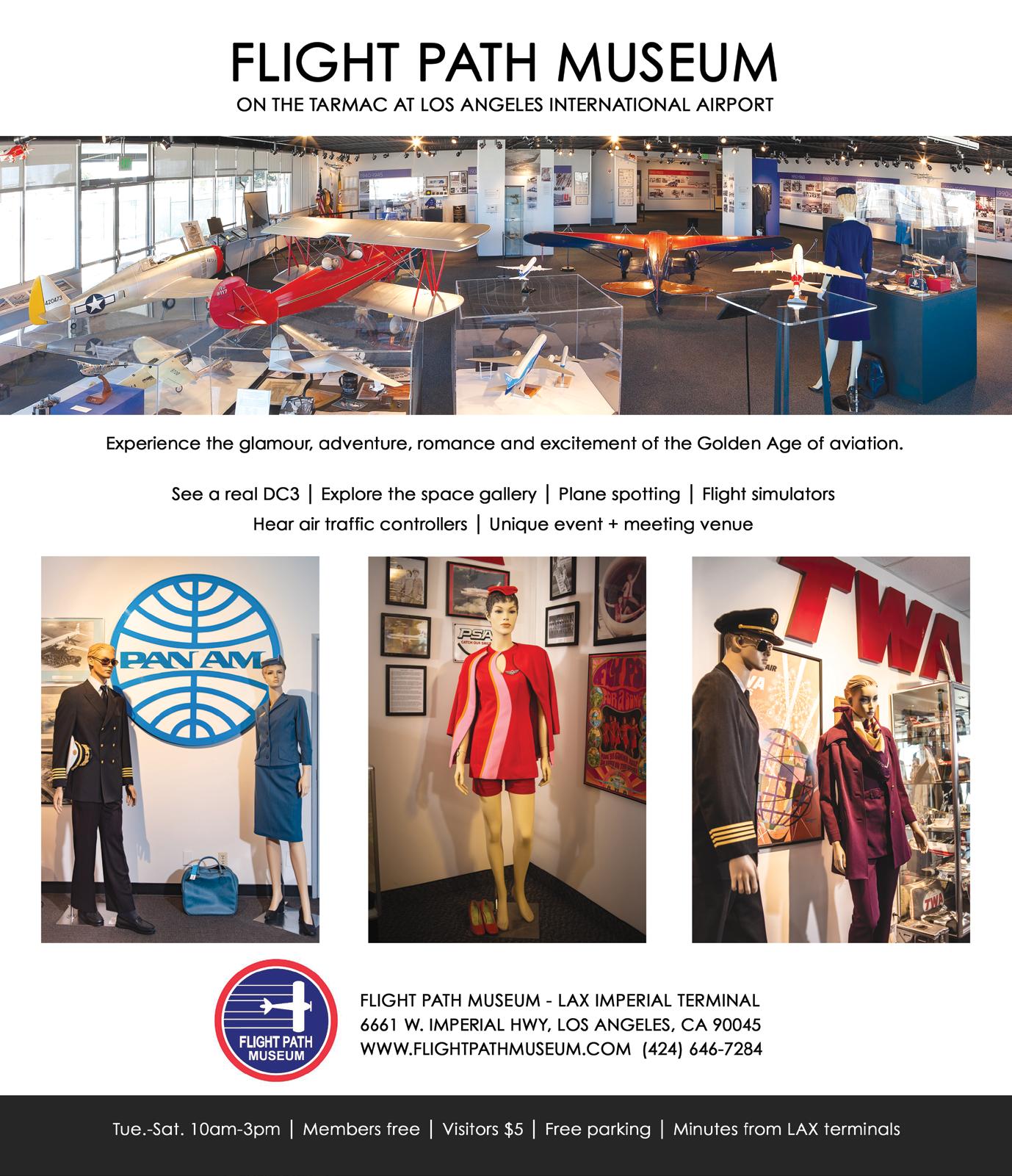
Into the Wild
Connect with Borneo’s orangutans and the people dedicated to conserving them and their habitat. BY MARLENE GOLDMAN
FREE TO ROAM: (Left to right) Mother and baby orangutans in Semenggoh, and orangutans in Matang and in Semenggoh
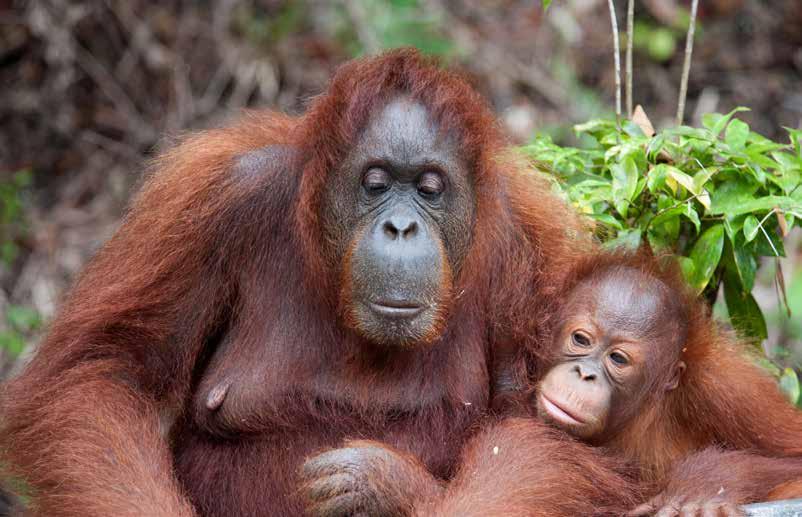
MEMBERS OF OUR WELCOMING COMMITTEE at Camp Leakey climb around the wooden slats of the jetty, anxiously awaiting our arrival. The unrelenting equatorial sun highlights their orange tufts of hair, their playful antics offering a distraction from the tropical heat.
One of the orangutan greeters, Percy, befriends several of the tourists who have come to this renowned research area in Tanjung Puting National Park, located in Kalimantan, or Indonesian Borneo. Borneo boasts the world’s oldest tropical rainforests which, until a few decades ago, completely covered the island. Only 50 percent of forest cover remains; 25 percent disappeared since the 1980s as virgin forest was converted into oil palm plantations. The loss of habitat makes orangutan refuges and sanctuaries critical to their survival. Many of us arrive at Camp Leakey on a klotok, a wooden boat that ferries tourists along Senoyer River to the park. My three-day trip includes two nights sleeping on deck.
Percy joins us as we walk to the feeding platform where orangutans being rehabilitated to live in the wild receive supplemental meals of fruit and milk as they learn to forage on their own. Mothers, babies and a few males indulge in papaya, bananas, durian and other fruit. Some linger in the branches overhead while others quickly depart with their bounty into the surrounding forest.
We make our way to the research center, established in 1971 byDr. Biruté Galdikasand her former spouse, Rod Brindamour. The center was named after paleo-anthropologist Louis Leakey, a mentor to Galdikas as well as to Dr. Jane Goodall, known for her work with chimpanzees, and Dr. Dian Fossey, who researched mountain gorillas.
The name orangutan, Malay for “man of the forest,” aptly describes these great apes who share 97 percent of their DNA with humans. The World Wildlife Fund estimates the Bornean orangutan population at about100,000 — putting them on the endangered list. More dire reports estimate 70,000–100,000 orangutans remain in Borneo, meaning the population reduced by more than half from 1999 to 2015. “The more I get to know orangutans, the more I get to know how human they are,” said Galdikas, who has studied Borneo’s orangutans for more than 50 years. “As similar as they are, they are also different. They are solitary in the wild. They are meditative and contemplative. They look you in the eye and see into your soul. … I have been wonderfully blessed and fortunate to spend many years with them and continue to do so. I don’t want them to perish from this Earth.”
Galdikas helped establish Orangutan Foundation International, which operates Camp Leakey and is dedicated to the conservation of wild orangutans and their rainforest habitat.
The research center area attracts resident orangutans including Big Tom, an adult male with an impressive set of flanges, or cheek pads. I also meet Siswi, the first orangutan born to an ex-captive at Camp Leakey. Dubbed the Queen of Camp Leakey, she plays up the part, posing for cameras and reveling in the attention. As habituated to humans as the orangutans seem, they remain free to forage and nest anywhere in the reserve.
Camp Leakey is one of several feeding stations in Tanjung Putting

National Park. I also visit Tanjung Harapan, the first station in the rehabilitation process. Orangutans that pass the semi-wild phase move to Pondok Tanggui, where researchers monitor them from a distance. The park requested two new feeding stations along the Sekonyer River, where illegal miners have encroached.
“One of the mechanisms for preservation of the park is to build up tourism,” Galdikas said “Tourism provides local employment and also supplies more sets of eyes and makes it harder to take resources. Timber mining used to go on in the park. Also surface mining for gold and zircon, the substance that makes glass for Mercedes and BMWs. You need to process tons and tons of sand to get zircon. It’s very damaging.”
OFI offers eco-tours led by specialists including Galdikas, who spends six months of the year in Borneo. The Los Angeles-based foundation has sister locations in Canada, Australia and Lithuania. The states of Sabah and Sarawak in Malaysian Borneo, north of Kalimantan, offer options for orangutan encounters. In Sabah, the Sepilok Orangutan Rehabilitation Centre opened in 1964 as the first center in the world to rehabilitate orphaned orangutans. Here 60 to 80 of the primates live free in the 10,000-plus acres of protected land at the edge of Kabili-Sepilok Forest Reserve. The Sabah Wildlife Department operates Sepilok, obtaining additional funding from entrance fees and Orangutan Appeal UK.
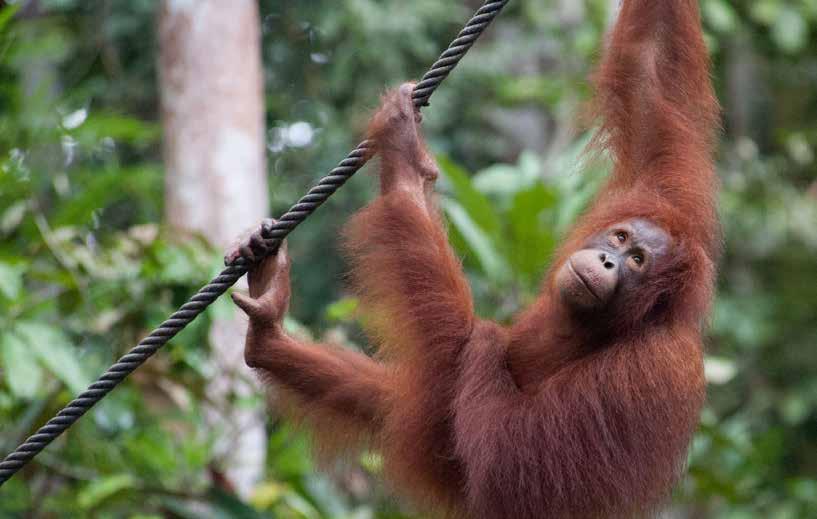
Many orangutans come as babies, caught during logging or forest clearance. Some are poached for the pet trade, though the Malaysian government outlawed the practice. The process to return to the wild can take up to seven years.
A small family of orangutans gorges on the fruit of a fig tree during my trip along the Kinabatangan River in the Lower Kinabatangan Wildlife Sanctuary, spanning 65,000 acres and protecting about 780 orangutans, along with other wildlife. The secluded Tabin Wildlife Reserve spans part of the peninsula of Sabah’s Darvel Bay. Created in 1984 to preserve disappearing wildlife, including Asian elephants, the reserve takes visitors on Jeep safaris.
Sarawak is home to Semenggoh Wildlife Centre, part of the Semenggoh Nature Reserve. Its rehab program moved to Sarawak’s Matang Wildlife Centre, but the reserve remains home to semi-wild orangutan families. As I arrive, a mom and baby greet me in the car park. At the feeding platform, residents swing in for bananas and coconuts, and the star of the show is Ritchie, Semenggoh’s alpha male at the time.
On a daytrip to Matang Wildlife Centre, part ofKubah National Park, I watch feedings of orangutans and sun bears. U.K.-based The Great Projectsoffers visitors volunteer opportunities at Matang and in Kalimantan’s Nyaru Menteng Orangutan Sanctuary, home to 393 orangutans, the largest number of captive orangutans in the world.
INFO TO GO Visitors to Tanjung Puting National Park can fly from Jakarta (CGK) and other Indonesian locations into Pangkalan Bun (PKN); from there an hour’s drive reaches the harbor of the Sekonyer River. Klotok houseboats with sleeping facilities are available at the harbor. You can travel to Sepilok from the Sabah city of Kota Kinabalu via a five-hour bus ride. Frequent 45-minute flights also operate from Kota Kinabalu International Airport to Sandakan Airport. From Sandakan, public buses run directly to Sepilok in 45 minutes and to Kinabatangan Wildlife Sanctuary in two hours. Flights also connect Sandakan to Lahad Datu Airport, near Tabin.
For Semenggoh, public buses run daily from Kuching. A 20-minute walk from the entrance takes you to the viewing area. Matang Wildlife Centre lies about a 40-minute drive from Kuching City. Since no regular bus goes directly to the center, hiring a taxi is recommended.
In the Groove

Find your smile in Fiji’s friendly paradise.
BY TIM LEFFEL
‘Bula’ means ‘life,’ but locals shout it with gusto for ‘hello,’ ‘goodbye,’ ‘welcome,’ ‘cheers,’ and ‘bless you’ after a sneeze. AS OUR SMALL PLANE left the main Viti Levu island behind and we made our way toward the Yasawa string of islands, the Fiji we dreamed of stretched out below us. Green tropical islands ringed by beaches, the South Pacific waters in shades of blue in between. When the seaplane landed near the beach at Turtle Island Resort, bare-chested men carried the women ashore while others sang a welcome song.
Singing is a key part of the Polynesian culture in Fiji, and it’s one of the strongest memories that lingers with me after my visit. The serenading starts at the international airport, where musicians and singers greet arriving visitors. It then continues at the
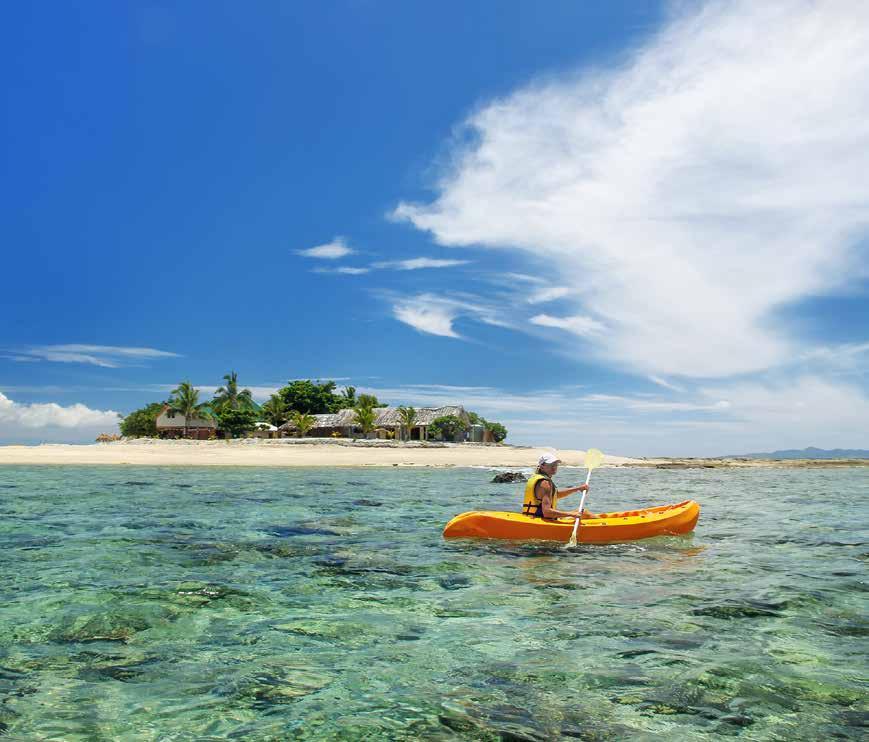
resorts, where you will probably hear music throughout the day and night, sometimes spontaneously. In this country, a staffer who doesn’t sing should probably be viewed with skepticism.
After such a long flight to get here from most of the world, you might want to spend your first night or two getting acclimated to the new time zone near Nadi, where the main international airport sits. In the Denerau Island development with a long beach and golf course, choose from a Westin, Sofitel, Sheraton, Hilton and Radisson Blu … and dozens of restaurants.
To feel the real beauty and essence of Fiji, though, get away from the entry point and find your own piece of paradise. Still a wild place with a lot of sparsely populated land, Fiji draws adventure travelers who come here to hike steep mountains, go caving, swim under waterfalls and ride down rivers. The rugged interior of Fiji’s two biggest islands
INFO TO GO Fiji Airways operates daily direct flights from Los Angeles (LAX) and Honolulu (HNL) to Nadi (NAN), the main gateway city for air service. Connecting flights on other airlines transit through Tokyo (NRT), Hong Kong (HKG), Singapore (SIN) and three Australian cities. Transportation from the airport to Denerau Island hotels or a seaplane departure point runs $20–25 by taxi, $40 by car service. Fiji Link offers domestic commercial air service to other islands and the capital.
offers enough adventure options to last for weeks. The firewalkers of Beqa Island remind people of the country’s unique history as they walk barefoot across glowing red coals.
Most vacationers, however, come here to find their own version of South Pacific, to discover the kind of tropical island they usually see only in someone else’s Instagram feed. They take the long trip across the ocean to de-stress, enjoy pictureperfect sunsets and swim with fish of 100 colors under the water. Fortunately, more than one spot in this destination fits the bill. More than 300 islands have their own secret beaches, quiet coves and prime snorkeling spots waiting for you.
The Mamanuca Islands, filming location of the Tom Hanks movie Cast Away, sit close enough to Nadi to reach by boat in two hours. A wide range of lodging options includes — surprisingly — Fiji’s only overwater bungalows: Likuliku Lagoon Resort. The resorts all lie within easy reach from the international arrival point, and some even transport you by helicopter.
The skinny string of Yasawa Islands to the north are a short hop by seaplane (or a longer one by boat), and they make it easy to feel like an adventuring explorer. The archi
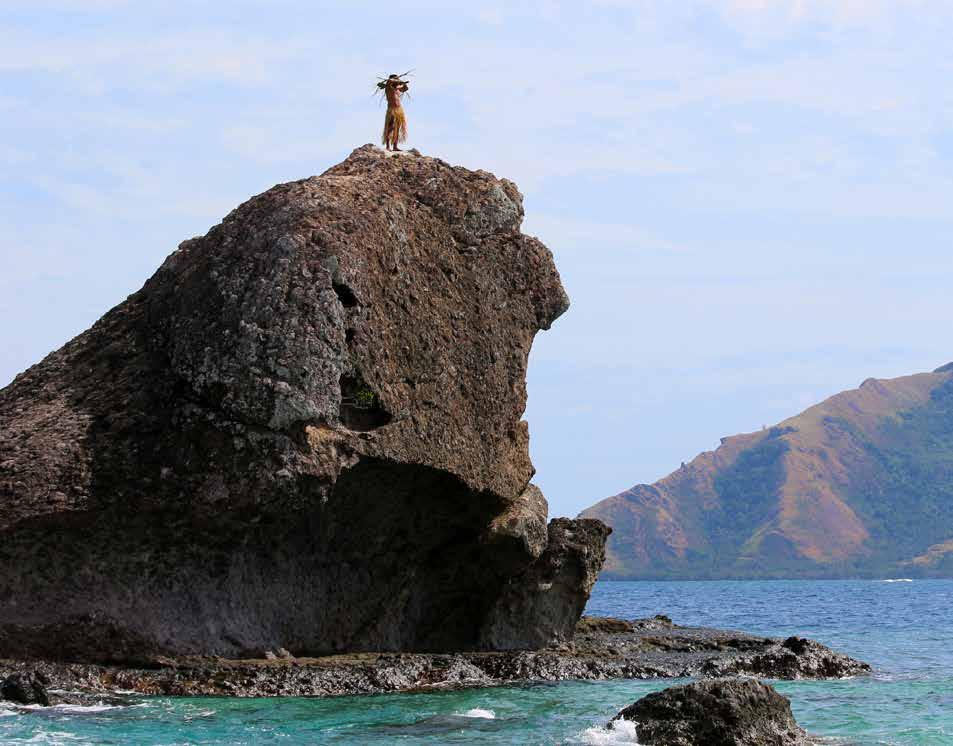
pelago includes some of the country’s original private-island resorts, places like Turtle Island, where guests rotate having their own private beach for the day; and Yasawa Island Resort, where each bungalow features its own beach cabana, hammock and outdoor shower at the ready. Nearly every island boasts a nearby coral reef teeming with fish in waters always pleasantly warm for swimming.
The high-end resorts usually provide direct air service, but tourist ferries also serve Yasawa and Mamanuca islands, where visitors can hop on and off at the various island ports. With a little planning it’s possible to set up a beach-hopping vacation with some changes of scenery.
Fiji’s second-largest island, Vanua Levu, offers plenty to do inland and on the water. Housing some of the most reasonably priced places to stay, it also includes a few resorts attracting international jet-setters. Laucala Island, one of the most famous, lies off the coast of Taveuni Island and hosts 25 villas on 3,500 acres of land. It’s partly famous because of its developer, the founder of Red Bull — someone who could afford to spare no expense.
No matter where you end up for your relaxation time, you will probably participate in a kava ceremony to loosen up even more. This is not something put on for tourists:
ISLAND ESSENCE: (Left to right) A Fijian boy entertains visitors with a traditional song; a young woman kayaking near South Sea Island, Mamanuca Islands; a Fijian warrior greeting the arrival of the Yasawa Flyer, a comfortable, fast catamaran connecting most of the Yasawa Islands
PHOTOS: © HEL080808 - DREAMSTIME .COM, © DONYANEDOMAM - DREAMSTIME.COM, © MARCO RAMERINI - DREAMSTIME.COM
LODGING
LAUCALA ISLAND Occupying a small slice of land on a self-sustained island, all-inclusive Laucala has 16 staffers for every guest staying at one of the 25 villas. Laucala Island $$$$$
TURTLE ISLAND FIJI RESORT On the island where the movie Blue Lagoon filmed, the original laid-back, luxury, allinclusive private island resort remains one of the best.
Turtle Island $$$$$
VOMO ISLAND FIJI This family-friendly option has a wild kids club reached by a suspension bridge, and children have the option of eating with other kids for lunch or dinner, giving parents a vacation break. Vomo Island $$$$$
TREASURED TRADITIONS: The national kokoda fish and coconut dish (right), and a Fijian warrior in full ceremonial tapa dress presenting a bilo (coconut shell) full of kava to a guest (below)
PHOTOS: © MAURIE HILL - DREAMSTIME .COM, © RAFAEL BEN ARI - DREAMSTIME .COM
DINING
Most Fiji resorts are all-inclusive or include mandatory meal plans. Plus, Fiji has 300-plus islands, so these choices all lie in the Nadi area, where international visitors arrive and depart.
INDIGO INDIAN AND ASIAN RESTAURANT Often hailed as the best upscale Indian restaurant on the main island, Indigo is air-conditioned and vegetarian-friendly. The Port at Denarau, Shop R3, Denarau Island, Nadi $$$
NADINA AUTHENTIC FIJIAN RESTAURANT This waterfront option serves upscale versions of local food presented with a flair, with an emphasis on fresh seafood. The Port at Denarau, Shop R1 & R2, Denarau Island, Nadi $$$
TATA’S CURRY HOUSE Located near Nadi’s biggest and most famous Indian temple, this locals’ favorite is not much to look at, but it serves up fiery curries that are definitely not watered down for tourists. Nadi Back Road, Nadi $$
Even trekkers stumbling into remote mountain villages will see this important social custom in practice. Along with the national fish and coconut dish kokoda, kava is a traditional part of daily life for adults. Fijians make the mildly intoxicating drink from the root of a pepper tree, mixing a large enough quantity in a large cauldron for a big crowd to share.
Participants generally sit in a circle on the ground. When it’s your turn to drink, you clap once with your hand cupped to make a specific sound, down the drink from a vessel usually made from half a coconut shell, then clap again three times. It tastes like, well, something made from a root, but it will make you smile like an honorary Fijian.
Fiji is hot all year and runs on island time, so there’s seldom a reason to dress up, cover up or be in a hurry. As you can only reach most of the outer island resorts by prop plane, heavy, overpacked suitcases are a bad idea. On many flights, passengers and their luggage both go on a scale for weight distribution.

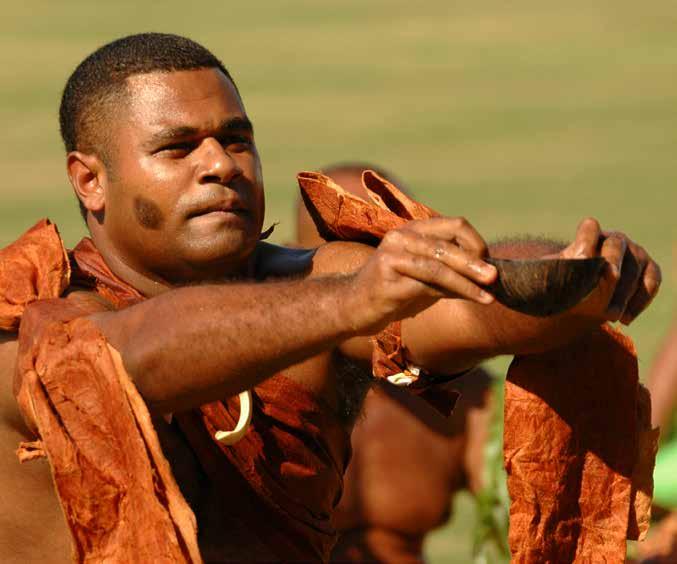
The best way to get into the groove on these islands is just to let things happen as they happen, in their own time. Sure, enjoy the progress in lodging comfort since the first explorers landed, but then relax and appreciate the natural attributes. Savor the chance to enjoy that perfect beach, that perfect sunset and a glorious day in the tropical sea.
Make Global Traveler your travel companion! Like our Facebook page; connect with us on LinkedIn; and follow us on Twitter, Instagram and Pinterest for travel updates, deals and more. Share your updates with us by using #globility. If you haven't checked them out lately, here's a sampling of what you may have missed:
FIND US HERE
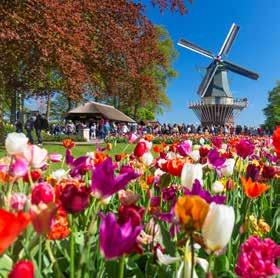
See spring in full bloom with a trip to one of these blossoming hot spots. Mandarin Oriental Ritz, Madrid reopens this summer after the hotel’s most extensive restoration.


More travelers prefer to stay at an Airbnb or other alternative accommodation over a hotel. Like us on Facebook to stay updated and interact with fellow travelers.
Follow GT’s Instagram, @globaltravelermag, for the best #snapshots from around the globe.
Four Seasons St. Louis adds a new entertainment option for guests.
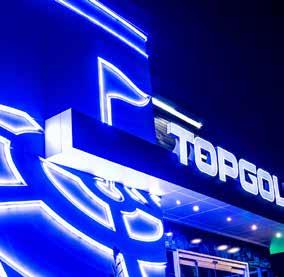
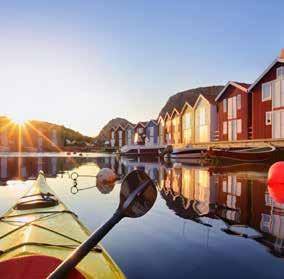
Delta Air Lines is hoping a new feature on its Fly Delta app will cut down on overcrowding at the gate. The new feature allows for virtual queuing ahead of boarding, as of last month.

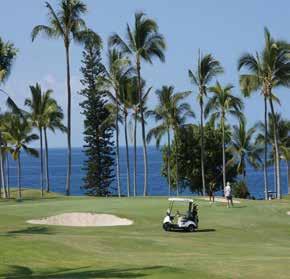
How to Get Your Real ID Before the October Deadline

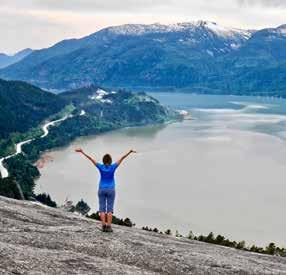
Connect with us on LinkedIn to stay informed on the world of business travel.
Follow us on Pinterest, or choose your favorite GT boards at pinterest.com/global traveler.
Follow our Twitter account, @GTmag, for the latest #travelnews and #traveldeals.
Kayak through Finland, go on an outdoor adventure in Arctic Sweden and more when you book a holiday through Off the Map Travel. You’ll golf like a pro after attending Four Seasons Resort Hualalai’s golf academy. Whether you’re completing bucket-list items or being more adventurous, these two hikes in Canada are a must.










